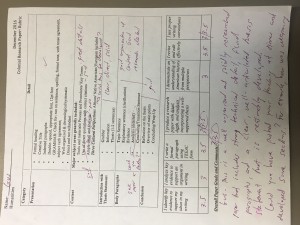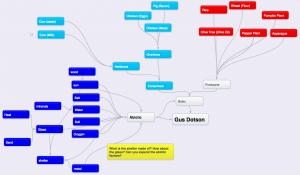One of our classes main projects in humanities has been essay writing and the finer points involved in a high quality essay. We have learned the basic components and how to work them into nicer sounding words. Our fist essay in this form was about the first book we read that year. This essay is about the most recent book we have read called The Crusible by Aurthur miller.
Here is the essay split into the basic components:
Outline for Crucible/McCarthy Comparative Essay
Theme: scapegoating
Paragraph #1: Introductory Paragraph (GIT)
Grabber Statement (G):
Just because of the color of your skin or your beliefs you can be marginalized by those in power and blamed for things you didn’t do.
Introduction of Theme (I):
Throughout history people have been scapegoated and marginalized because of their gender, their race or their beliefs. People in power wish to have an unblemished reputation so they blame minority’s for their problems.
Thesis Statement (T):
Throughout history people in power have scapegoated minorities and blamed them for their problems. Often times they were blamed because of their beliefs or because of the color of their skin.
_________________________________________________________________________
Paragraph #2: Crucible Thematic Connection
Topic Sentence (T):
In the Crucible by Arthur Miller when people are scapegoated they immediately put the blame on others because they don’t want the spotlight on themselves and wish to escape the oppression that is shed on them.
Explanatory Sentence (E):
What this means is that one person will blame someone for something they didn’t do because they are trying to redirect the blame onto someone else. Tituba does this to other poor, disempowered women in the play.
Evidence (E):
“And I look—and there was Goody Good and Goody Osburn,” (Miller, p. 63–65).
Analysis (A):
This shows that when one person is scapegoated they will scapegoat others so they can step out of the spotlight.This cycle of blame continues because of the fear that is created by the people in power.
Concluding/ Transition (C):
It is said that history repeats itself and I believe this because in the 1950s, about 258 years after the Salem witch trials there was an event very similar
__________________________________________________________________________
Paragraph #3: McCarthy/Red Scare Thematic Connection
Topic Sentence (T):
During the Red Scare, as in the salem witch hunts, many people were wrongfully scapegoated and blamed by rich or powerful people for things that they hadn’t done because of their country of origin or because of their beliefs.
Explanatory Sentence (E):
This means that a person would be blamed for committing a crime, because they are part of a minority group, even though they hadn’t actually done anything wrong.
Evidence (E):
There were many corrupt government officials that supported these actions, “J. Edgar Hoover… rounded up hundreds of russian immigrants… many of them had done nothing wrong.”
Analysis (A):
What this means is that these russians were rounded up and punished even though they hadn’t done anything wrong. These acts of discrimination have been going on for an unimaginably long time and range from racism to sexism and beyond.
Concluding/ Transition (C):
Thought the problem of scapegoating was prominent during the Red Scare it is still very clear today and is reflected a lot in our new president’s actions.
__________________________________________________________________________
Paragraph #4: Modern Day Witch Hunt Thematic Connection
Topic Sentence (T):
Due to the recent election, the United States Of America has elected a president that has scapegoated people that are of latin american descent because he wishes to have, as Arthur Miller says, an “all white name”.
Explanatory Sentence (E):
Trump doesn’t value diversity and difference and wishes to seem all good and flawless.
Evidence (E):
Tumpo has cracked down on law enforcement in a racist way, “… It translates to the unwarranted and illegal targeting of people because of their race, because of their language, because of the color of their skin.”
Analysis (A):
This quote shows that ICE officers are racially profiling and unfairly arresting people based on the color of their skin or the language they are speaking. It is a fact that many of the people they are arresting are from countries in latin america because people of Latin american descent tend to have different colored skin (NOT all but some). The ICE officers are less diligent on european immigrants or immigrants will lighter skin.
Concluding/ Transition (C):
Scapegoating is like a plague in our society and is terrible and unfair thing.
__________________________________________________________________________
Paragraph #5: Concluding Paragraph (ROC)
Reflection on Thesis (R):
Scapegoating has always been a problem and will always be one because people wish to be perfect and when they screw up they wish to have someone else to blame
Overview of Main Points (O):
No matter if it was two hundred years ago during the Salem witch trials, if it was during the red scare and McCarthy era or if it was yesterday it is still a problem and is very unfair.
Concluding Idea (C):
Imagine if you were blamed for murder and treason because of the color of your skin? Imagine being marginalized because of your beliefs or because of your gender? Would you like it? I think not.



